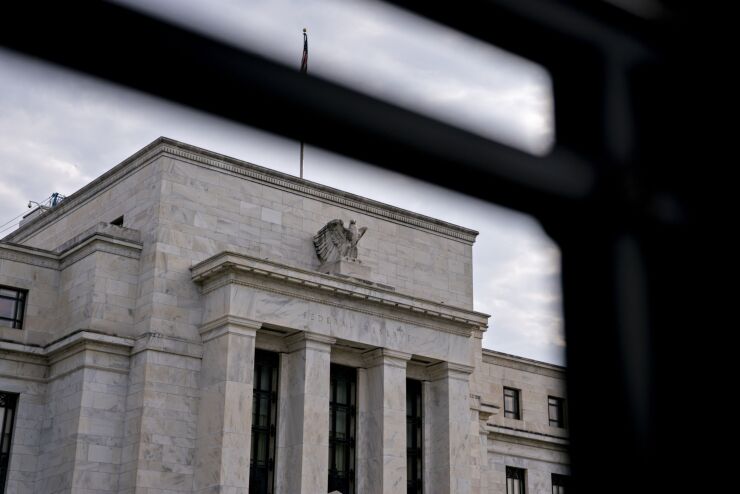The biggest U.S. banks are once again preparing to show how they'll be able to withstand a severe economic shock in a hypothetical doomsday scenario, and they're eager to get on with it as a real one unfolds.
They're opposed to suggestions that the Federal Reserve postpone annual stress tests, even though it means some staff will have to work longer hours to complete their submissions as fears about the coronavirus bring the global economy to its knees, according to executives and others familiar with the preparations.
The Fed devised the first stress test in early 2009 to reassure investors about the banks' stability in the wake of the U.S. mortgage meltdown, with the government ready to plug any holes the exam might reveal. It worked, especially after the firms raised an additional $100 billion of capital, helping to restore confidence in the banking system. Today, they're better capitalized, more liquid and eager to show they can absorb a shock even worse than the turmoil of the past few weeks, executives say.

"The stress tests have proven very important in establishing the strong position of the largest banks in our country," said Kevin Fromer, president of the Financial Services Forum, a trade association that brings together the chief executives of the eight firms that regulators consider systemically significant. "In a situation like this, that's reassuring to see. Our members believe that their institutions are a source of strength and can support the economy and their customers through this period."
The prospect of putting off stress tests has become a topic of discussion across the industry in recent weeks, with at least one group that also represents regional banks and European lenders suggesting the Fed give firms more time to meet the test's requirements.
The banks — including JPMorgan Chase, Bank of America and Citigroup — must submit their data and capital plans by April 6, with the Fed set to release the results in June. Even though some activity related to the submissions continues until the last minute, the bulk of the data is compiled by the end of February, according to the people familiar with the process. Last month, bank personnel were working late hours to prepare the information, which is now being reviewed by senior managers before going to their boards for approval.
Stock and bond prices cratered this month as the death toll from the virus mounted, prompting the World Health Organization to declare a pandemic, and an oil-price war erupted between Russia and Saudi Arabia. As efforts to contain the virus disrupt global travel and supply chains, investors worry that big losses and bankruptcies will follow.
The stress test assumes a harsh scenario — the U.S. economy contracting 9.9% and unemployment soaring to 10%, for example — to calculate potential losses that banks would face from rising defaults and bankruptcies and whether they have enough capital to cushion the blow.
Financial markets across assets have priced in an 80% probability of the current turmoil tipping into a recession, according to JPMorgan strategists. Even though the economic contraction might not get to the severity modeled in the stress test, some market indicators have already reached the levels foreseen in the severely adverse scenario used in the hypothetical exercise.
The big banks don't hold major securities positions but they are market intermediaries, said Sean Campbell, head of policy research at the Financial Services Forum. Meanwhile, Treasuries that they're required to hold provide a good hedge against market declines as a flight to safety lifts government bond prices, he said. In last year's test, just 22% of the hypothetical losses borne by the firms came from trading. More than 70% came from soured loans.
Yet the real test will be living through the economic impact from the virus and the oil shocks and seeing whether the biggest banks can deliver what they promise, said Kathryn Judge, a professor at Columbia University and an adviser to the Treasury Department's Office of Financial Research.
"Stress tests rely on imperfect models, which will only be proven accurate if banks can continue to support the economy during this period," she said. "Models are one thing, reality is another."
The big banks are much better capitalized than they were before the 2008 crisis and better-capitalized banks typically continue lending trough down cycles, Judge said. But the problem with the current situation is the amount of uncertainty over how bad the U.S. or global economy can get, which is also why investors are so spooked, she said.
The banks' liquidity levels also will be tested in coming months as credit lines are drawn down by corporate clients waiting on payments or seeing their revenue streams dry up. Earlier this week, several travel-and-leisure companies maxed out such facilities.
The Fed this week increased its support to the financial system, providing additional funds the banks can tap to provide their cash-strapped clients. While that's absolutely the right thing to do in the current situation, the Fed alone cannot ease the stress in the system, Judge said.
"The Fed doesn't have the answers to the current crisis," she said. "It's government measures against the virus that will matter, on how quickly the pandemic is controlled and how the impact is minimized."





